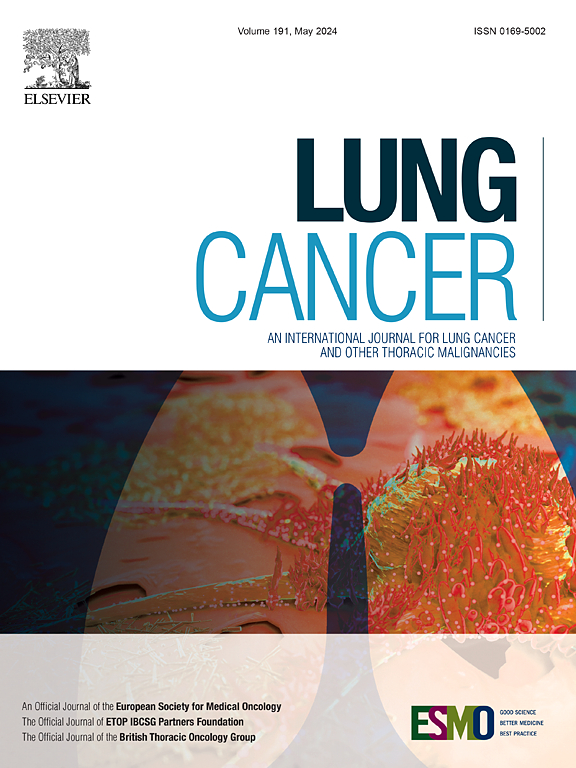BALF液体活检现在适用于疑似NSCLC患者的临床实践。
IF 4.4
2区 医学
Q1 ONCOLOGY
引用次数: 0
摘要
在早期非小细胞肺癌中,在治疗开始前进行准确的分子诊断变得越来越重要,因为获得足够的组织来生成分子数据可能具有挑战性。本研究评估了通过近端支气管冲洗获得的支气管肺泡灌洗液(BALF)中游离DNA (cfDNA)分析对疑似NSCLC患者的诊断价值。我们评估其潜力,以提高分子诊断和评估一致性与病理诊断。方法:接受支气管内诊断的疑似非小细胞肺癌患者。在液体活检分析过程中收集半胱氨酸。将结果与从原发肿瘤或疑似淋巴结收集的组织样本获得的分子诊断进行比较,如果没有从其他转移部位获得。结果:分析了93份BALF样本:77例确诊为恶性肿瘤,10例为良性疾病,6例诊断不明。在确诊的恶性肿瘤患者中,75%的病例在BALF中检测到致病性变异。BALF分析将治疗前组织中没有分子诊断的患者比例降低了50%。BALF中位变异等位基因频率(VAF)为5.0%。在68例可评估病例中,使用基于组织的分子诊断作为金标准计算灵敏度(78%)、特异性(67%)、PPV(94%)和NPV(32%)。结论:本研究表明,通过近端支气管灌洗获得的BALF液体活检是可行的,并且可以在任何以肺为重点的临床中实施。BALF提供了一种有价值的微创诊断选择,具有增强肺癌诊断和患者管理的潜力。本文章由计算机程序翻译,如有差异,请以英文原文为准。
Liquid biopsy in BALF is now suitable for clinical practice in patients with suspected NSCLC
Introduction
An accurate molecular diagnosis prior to treatment initiation is increasingly important in earlier stage NSCLC where obtaining sufficient tissue to generate molecular data can be challenging. This study evaluates the diagnostic value of cell-free DNA (cfDNA) analysis from bronchoalveolar lavage fluid (BALF) obtained via a proximal bronchial flush in patients suspected of NSCLC. We assess its potential to improve molecular diagnosis and evaluate concordance with pathological diagnosis.
Methods
Patients undergoing endobronchial diagnostics with suspected NSCLC were included. BALF was collected during the procedure for liquid biopsy analyses. Results were compared with molecular diagnoses obtained from tissue samples collected from the primary tumor or suspected lymph nodes, and if neither available from other metastatic sites.
Results
93 BALF samples were analyzed: 77 from patients with a confirmed malignancy, 10 with benign disease and six with unknown diagnoses. In patients with confirmed malignancy, a pathogenic variant was detected in BALF in 75% of cases. BALF analysis reduced the proportion of patients without a molecular diagnosis in tissue prior to treatment by 50%. The median variant allele frequency (VAF) of mutations detected in BALF was 5.0%. In 68 evaluable cases, sensitivity (78%), specificity (67%), PPV (94%), and NPV (32%) were calculated using tissue-based molecular diagnosis as the gold standard.
Conclusion
This study demonstrates that liquid biopsy of BALF, obtained through proximal bronchial lavage, is feasible and ready to be implemented in any lung-focused clinic. BALF presents a valuable, minimal-invasive diagnostic option, with the potential to enhance lung cancer diagnostics and patient management.
求助全文
通过发布文献求助,成功后即可免费获取论文全文。
去求助
来源期刊

Lung Cancer
医学-呼吸系统
CiteScore
9.40
自引率
3.80%
发文量
407
审稿时长
25 days
期刊介绍:
Lung Cancer is an international publication covering the clinical, translational and basic science of malignancies of the lung and chest region.Original research articles, early reports, review articles, editorials and correspondence covering the prevention, epidemiology and etiology, basic biology, pathology, clinical assessment, surgery, chemotherapy, radiotherapy, combined treatment modalities, other treatment modalities and outcomes of lung cancer are welcome.
 求助内容:
求助内容: 应助结果提醒方式:
应助结果提醒方式:


